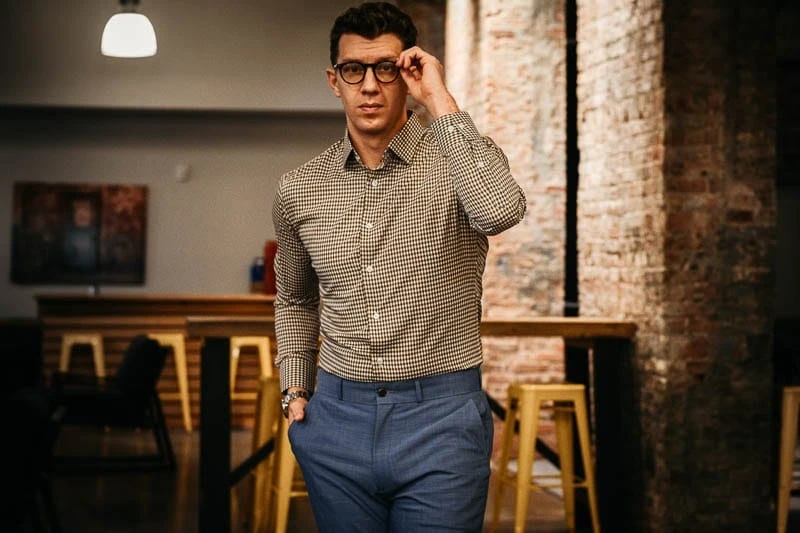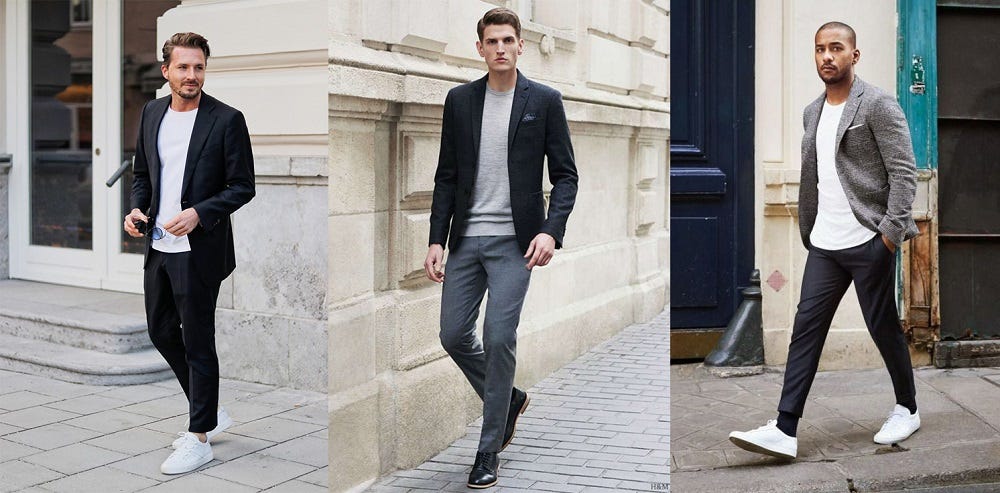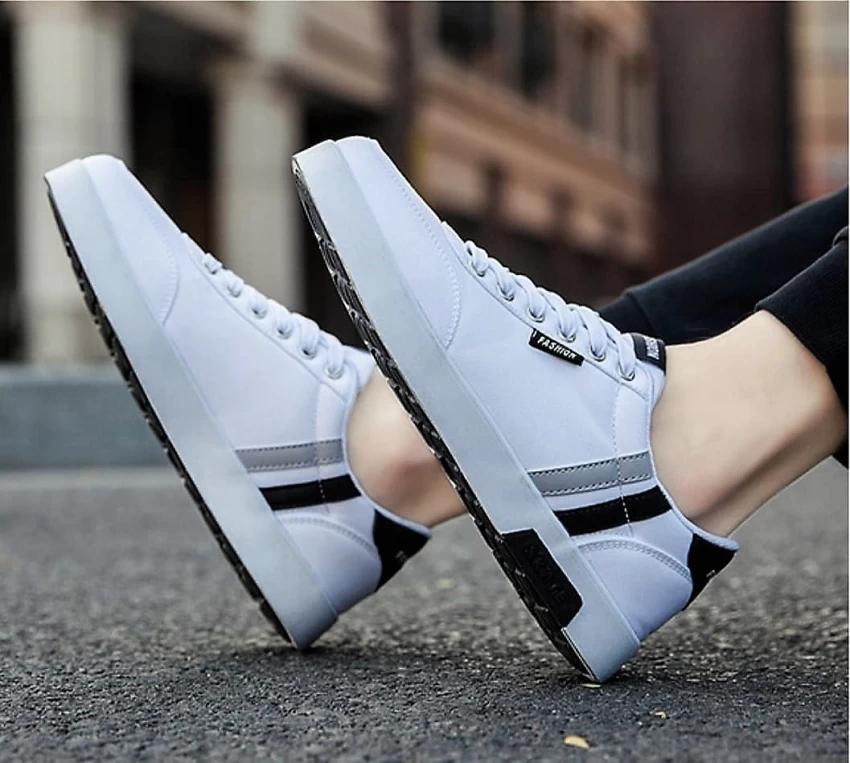Business casual men outfits, a Canadian electro-funk duo, is available. Not only is men's business casual a confusing term, but it also has a clothing code, which is as confusing. It is not appropriate to take business casually. Which oxymoron thought up that not-so-clever idea?
According to Josh Sims, author of Men of Style, "business casual men outfits is one of those ridiculous dress codes, like smart-casual, that created bewilderment before it did anything to make people feel more at ease." Positively, it contributed to a shift in perceptions about what men might and should wear to white-collar jobs, foreshadowing the collapse of workplace dress standards in the last few decades, particularly with the rise of technology.
Advice For Styling A Business Casual Men Outfits
1. Restructure Your Officewear

But remember that a gold-buttoned, double-breasted dress is still much too formal for smart-casual.
Go for something more carefree, or unstructured, meaning that the shoulder pads should be minimal or non-existent. A little shorter length sounds more informal and modern as well. Italian retailers like Boglioli, Barena, and Aspesi are industry leaders in this area, but high-end retailers like Reiss and J. Crew also offer good examples.
A quality unstructured blazer is so soft, and some versions are knit or even made of jersey, that it almost feels like a cardigan. It's created from malleable fabrics like boiled or Merino wool. Though still more informal, they are nevertheless more sophisticated than a hoodie.
2. Jack In Your Jacket
An excellent business-casual option is a shawl-collar cardigan, should even the loosest tailoring feel too stiff. Just remember that you are still there to work, so stay away from thick ribbing, outdoorsy toggles, and folksy designs.
A chore jacket is distinct from traditional "work wear," but it's nonetheless sharper than a denim jacket—especially if it's a dark wash and not distressed—because it resembles a blazer.
Combining the military with its uniformity, a lightweight bomber may function as a blazer. The secret here is to avoid using the typical glossy nylon and instead choose a dark colour, like navy, in a less functional fabric, like wool, cotton, or linen.
3. Be A Team Player
Nothing says "catalogue model" quite like an open-collared shirt and a V-neck sweater. A crew-neck style is definitely sportier and more contemporary. Besides, a tie doesn't require any room. Even better, you can amp up the athletic feelings with a fabric that mimics the classic "V" embroidered at a sweatshirt collar. Alternatively, if it's thin enough, replace your real jersey sweatshirt with a knit one to give your jacket and trousers a more athletic rather than nerdy vibe.
Conversely, you could also wear a zip-up track top or a knit bomber. They feel more formal and sophisticated because to the cloth, and you too will feel somewhat more put together with to the hardware and military/athletic profile.
4. Dress Down Everyday

Rather than glossy poplin, a soft-collared button-down shirt made of a fabric like Oxford is a far better choice.
Once again, button-down shirts tend to seem a little too stock picture; denim or chambray instead of Oxford fabric provides visual character and a hint of ranch-hand roughness. Conversely, a collarless shirt or grandfather looks current and professional—not like you forgot your tie. In either case, if you choose to wear your shirt untucked, make sure the tails aren't too long.
A polo, which is in between a shirt and a T-shirt, is a good substitute as well, particularly if it has long sleeves and is made of a higher-quality material like merino wool. This can also be worn as an alternative to a regular button-down beneath a jacket.
5. Slack Off (Or On)
The components of a smart-casual ensemble (as well as the pieces that make up those components) are comparable to the levels on a DJ's mixing console. To balance things out, if some are cranked up to the extreme, the others should be toned down as well, but not to the point where they become discordant.
For instance, fitted pants may tilt the scales too much in favour of smart if you're wearing a jacket, shirt, and brogues. A bomber, T-shirt, and sneakers, on the other hand, go better with tailored pants to avoid seeming overly casual. The levels may also be changed by replacing the brogues with trainers or the shirt with a T-shirt.
Be cautious when using any material that is too thin or glossy for individually fitted pants. Wearing anything with denim or other casual materials and components goes better with something beefier, more textured, and less suit-like.
6. Work Some Workwear
Although jeans are definitely on the more informal end of the legwear spectrum, they may still be worn in a smart-casual setting as long as they are dark, which elevates them, and not frayed, which also elevates them.
Generally speaking, style guidelines will advise you to get dark blue jeans, ideally made of unwashed selvedge denim. They're not incorrect, but blue may occasionally be overly rational. Since rivets and stitching are often tonal but also more rock 'n' roll, black is a wiser choice. Another unexpectedly elegant colour combination is black and blue.
Steer clear of jeans with excessive embellishment and don't follow the torn knee trend. A sleek, contemporary pair will look better with your monochromatic, norm core ensemble. Like with chinos, turn-ups quickly elevate any pair of jeans or outfit to a more relaxed vibe.
Recommended to Read: Trending Men’s Short Styles For Summer
7. Check The Footsie Index

It is frequently the case that smarter shoes are sleeker, shinier, and more refined, and vice versa. Thus, brogues will help you establish a strong, smart-casual foundation; but, a hefty Derby can seem more modern.
Similar to T-shirts, sneakers might be problematic in a smart-casual setting. Fortunately, just as with joggers, "dress" trainers are becoming more and more popular these days. These often include a white sole with a black leather top. White shoes can seem classy, but only if they're clean—both minimally stylish and not filthy.
The other factor to consider is sleekness, just as with any shoe. You may wear a bulky dress shoe with trainers since they are already very casual; but, a high-top will seem much less formal. Styles that precisely balance the smart-casual line (or hyphen) include minimal branding and stitching, which may discolour easily.
8. Pack Up
Any of the aforementioned styles would go well with a soft leather briefcase. A backpack will seem more on-message than a messenger bag in a smart-casual job, however it could be too junior in a formal office. Invest in a mature one that has a dark colour, maybe lined with leather for an elegant look, and good hardware (sturdy zips, for example).
If you're a man who has to transition between the sophisticated and informal aspects of smart-casual, search for a bag that can be carried by a top handle to make it look more like a briefcase or tote bag. An increasing number of manufacturers are creating hybrid carriers that can convert between different designs.
9. Clock On
Even a T-shirt and jeans outfit will look better with a dapper watch on a silver bracelet. It's sportier and more casual than a leather strap because of that, and the sheer expanse of bright metal adds much-needed gloss to your casual ensemble.
Alternatively, you might consider a Milanese mesh strap, which would have a similar look and falls in style midway between a leather strap and a bracelet. Even if the wrist candy you have is merely quartz.
FAQs
Describe men's casual business attire?

Business-casual attire, according to its name, has proven to be inconsistent. However, business-casual has become a ubiquitous mentality, partly due to California's prominence as a producer of apparel and culture. Tech businesses were considered as cutting edge both back then and now. Desperate to be trendy and to be recognized as embracing best business practices, other companies swiftly followed (or did not follow) suit.
Globally, business casual men outfits is becoming the norm. In the House of Commons, members of parliament are no longer required to wear ties for "business-like attire," and in 2013, leaders were expected to wear "smart-casual" clothes.
Banks are also adopting the look: in 2016, JP Morgan launched "business-casual," despite staff members' worries that they wouldn't appear to have any clients. With the disclaimer, "Please exercise judgement in determining when to adapt to business attire as circumstances dictate, particularly if you have a client meeting," Goldman Sachs has implemented a "casual" dress code.
The origins of business-casual attire for men?
Silicon Valley gave birth to business-casual in the 1980s. It was the outcome of independent, small businesses run primarily by men who valued output above procedure and spent more time in front of computers than with other people.
Sims adds, "Business-casual was a distinctly American idea to inculcate a work culture of inclusivity." It's true that your boss may always look nicer than you, but at least on "Dress-Down Friday," everyone is required to wear equally embarrassing outfits. The suit was discarded and replaced with khakis and polo shirts, if not Hawaiian shirts.
The origins of Casual Friday may be traced, if not literally, to 19th-century British tweed suit wearers who took the train to their weekend rural estates. Then, in 1966, a marketing wizard at the Hawaiian Fashion Guild created "Aloha Fridays," which contributed to the emergence of the concept of casual dressing in the workplace.
How should guys dress for business casual men outfits?
What Does a Man Dress for Business Casual? Men should wear formal pants or chinos, a button-down shirt, black socks, and dress shoes for business casual. Even if they are appropriate for the position in question, avoid wearing polo shirts to an interview.
